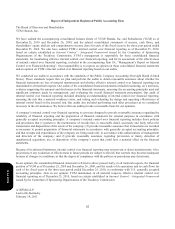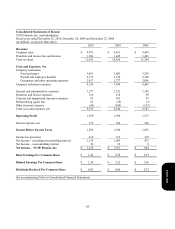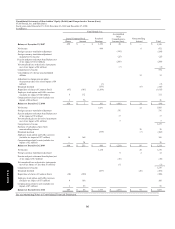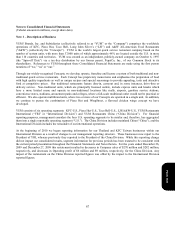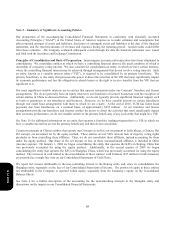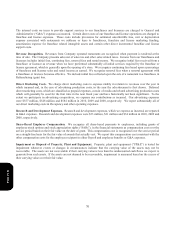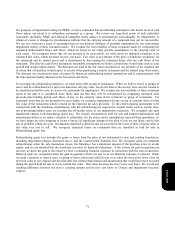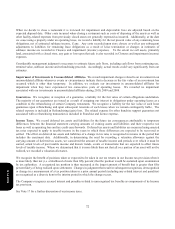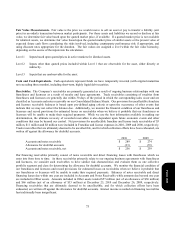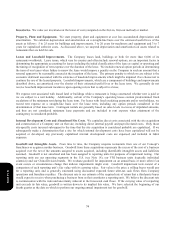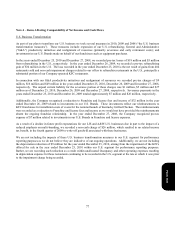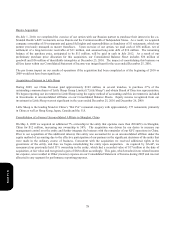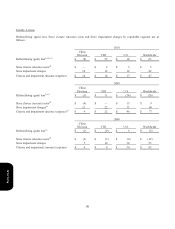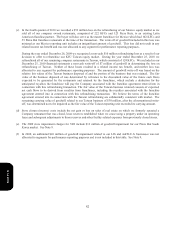Pizza Hut 2010 Annual Report Download - page 169
Download and view the complete annual report
Please find page 169 of the 2010 Pizza Hut annual report below. You can navigate through the pages in the report by either clicking on the pages listed below, or by using the keyword search tool below to find specific information within the annual report.
72
When we decide to close a restaurant it is reviewed for impairment and depreciable lives are adjusted based on the
expected disposal date. Other costs incurred when closing a restaurant such as costs of disposing of the assets as well as
other facility-related expenses from previously closed stores are generally expensed as incurred. Additionally, at the date
we cease using a property under an operating lease, we record a liability for the net present value of any remaining lease
obligations, net of estimated sublease income, if any. Any costs recorded upon store closure as well as any subsequent
adjustments to liabilities for remaining lease obligations as a result of lease termination or changes in estimates of
sublease income are recorded in Closures and impairment (income) expenses. To the extent we sell assets, primarily
land, associated with a closed store, any gain or loss upon that sale is also recorded in Closures and impairment (income)
expenses.
Considerable management judgment is necessary to estimate future cash flows, including cash flows from continuing use,
terminal value, sublease income and refranchising proceeds. Accordingly, actual results could vary significantly from our
estimates.
Impairment of Investments in Unconsolidated Affiliates. We record impairment charges related to an investment in an
unconsolidated affiliate whenever events or circumstances indicate that a decrease in the fair value of an investment has
occurred which is other than temporary. In addition, we evaluate our investments in unconsolidated affiliates for
impairment when they have experienced two consecutive years of operating losses. We recorded no impairment
associated with our investments in unconsolidated affiliates during 2010, 2009 and 2008.
Guarantees. We recognize, at inception of a guarantee, a liability for the fair value of certain obligations undertaken.
The majority of our guarantees are issued as a result of assigning our interest in obligations under operating leases as a
condition to the refranchising of certain Company restaurants. We recognize a liability for the fair value of such lease
guarantees upon refranchising and upon subsequent renewals of such leases when we remain contingently liable. The
related expense is included in Refranchising (gain) loss. The related expense for other franchise support guarantees not
associated with a refranchising transaction is included in Franchise and license expense.
Income Taxes. We record deferred tax assets and liabilities for the future tax consequences attributable to temporary
differences between the financial statement carrying amounts of existing assets and liabilities and their respective tax
bases as well as operating loss and tax credit carryforwards. Deferred tax assets and liabilities are measured using enacted
tax rates expected to apply to taxable income in the years in which those differences are expected to be recovered or
settled. The effect on deferred tax assets and liabilities of a change in tax rates is recognized in income in the period that
includes the enactment date. Additionally, in determining the need for recording a valuation allowance against the
carrying amount of deferred tax assets, we considered the amount of taxable income and periods over which it must be
earned, actual levels of past taxable income and known trends, events or transactions that are expected to affect future
levels of taxable income. Where we determined that it is more likely than not that all or a portion of an asset will not be
realized, we recorded a valuation allowance.
We recognize the benefit of positions taken or expected to be taken in our tax returns in our Income tax provision when it
is more likely than not (i.e. a likelihood of more than fifty percent) that the position would be sustained upon examination
by tax authorities. A recognized tax position is then measured at the largest amount of benefit that is greater than fifty
percent likely of being realized upon settlement. Changes in judgment that result in subsequent recognition, derecognition
or change in a measurement of a tax position taken in a prior annual period (including any related interest and penalties)
are recognized as a discrete item in the interim period in which the change occurs.
The Company recognizes accrued interest and penalties related to unrecognized tax benefits as components of its Income
tax provision.
See Note 17 for a further discussion of our income taxes.
Form 10-K


